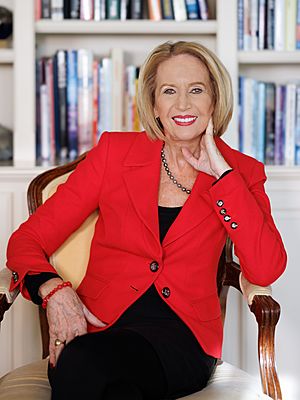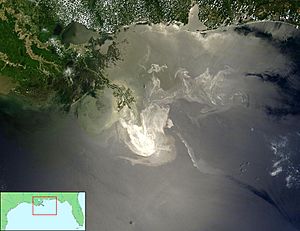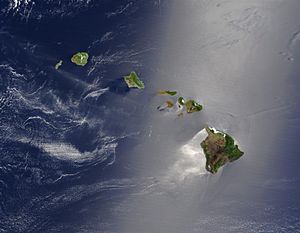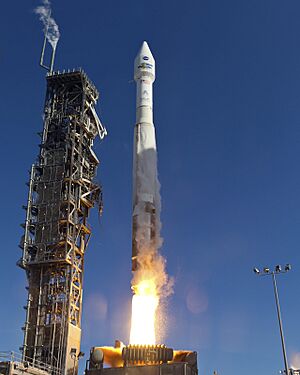Marcia McNutt facts for kids
Quick facts for kids
Marcia McNutt
|
|
|---|---|

McNutt in 2023
|
|
| 22nd President of the National Academy of Sciences | |
| Assumed office July 1, 2016 |
|
| Preceded by | Ralph J. Cicerone |
| 15th Director of the United States Geological Survey | |
| In office 2010–2013 |
|
| President | Barack Obama |
| Preceded by | Mark D. Myers |
| Succeeded by | Suzette Kimball |
| Personal details | |
| Born |
Marcia Kemper McNutt
February 19, 1952 Minneapolis, Minnesota, U.S. |
| Education | Colorado College (BA) Scripps Institution of Oceanography (MS, PhD) |
| Scientific career | |
| Institutions |
|
| Thesis | Continental and Oceanic Isostasy (1978) |
| Doctoral advisor | Henry William Menard |
Marcia Kemper McNutt (born February 19, 1952) is an American geophysicist. A geophysicist studies the Earth using physics. She is the 22nd president of the National Academy of Sciences (NAS) in the United States. This is a very important group of scientists who advise the nation on science and technology.
Before leading the NAS, McNutt was the 15th director of the United States Geological Survey (USGS) from 2010 to 2013. She was the first woman to hold this position. The USGS studies the Earth, its natural resources, and natural hazards. She also advised the United States Secretary of the Interior on science. Before working for USGS, McNutt was the head of the Monterey Bay Aquarium Research Institute (MBARI). This is a research center that studies the ocean. She was also a professor at several universities, including Stanford University and the Massachusetts Institute of Technology.
From 2013 to 2016, she was the editor-in-chief of Science, a very important science magazine. She also works at the Scripps Institution of Oceanography. She helps advise the National Academies of Sciences, Engineering, and Medicine on Earth and life studies.
Contents
Early Life and Education
Marcia McNutt was the top student in her class at the Northrop Collegiate School in Minneapolis. She graduated in 1970. She earned a bachelor's degree in physics from Colorado College in 1973. She then studied geophysics at the Scripps Institution of Oceanography. She received her PhD in Earth sciences in 1978. Her main project was about how continents and oceans balance on the Earth's surface.
After a short time at the University of Minnesota, McNutt worked for three years. She studied earthquake prediction at the US Geological Survey in Menlo Park, California. In 1982, she became a professor at the Massachusetts Institute of Technology (MIT). She also directed a program that worked with the Woods Hole Oceanographic Institution.
McNutt is a certified scuba diver. She even trained with the United States Navy's Underwater Demolition Team.
Marcia McNutt has three daughters: Meredith, Dana, and Ashley. Ashley was "Miss Rodeo California" in 2009. Marcia McNutt loves horses and enjoys barrel racing with her horse, Lulu.
In 1994, McNutt was one of 16 women professors at MIT. They wrote a letter to challenge unfair treatment against women at MIT. In 1996, McNutt married Ian Young, a ship's captain at MBARI.
Scientific Research
McNutt has been on 15 big ocean trips for research. She was the lead scientist on more than half of them. She has written about 100 scientific papers. Her research includes studying volcanoes on ocean islands in French Polynesia. She also studied how continents break apart in the Western United States. She looked at how the Tibet plateau rose up.
McNutt has helped us understand how strong and flexible the Earth's outer layer, called the lithosphere, is. She showed that young volcanoes can bend the lithosphere. This affects how high nearby volcanoes are. She also found a huge landform called the South Pacific superswell.
Monterey Bay Aquarium Research Institute (MBARI)

McNutt was the president and CEO of MBARI from 1997 to 2009. During her time there, MBARI's research ship, the RV Western Flyer, went on many trips. It explored areas from Canada to Hawaii. MBARI also built the Monterey Accelerated Research System (MARS). This was the first deep-sea cabled observatory in the United States.
U.S. Geological Survey (USGS)
Becoming Director
In July 2009, President Obama chose McNutt to be the next director of the United States Geological Survey. The United States Senate approved her choice in October. She was the first woman to lead the USGS since it started in 1879.
BP Oil Spill

During her first year at USGS, several big events happened. These included major earthquakes in Haiti and Chile. There was also the eruption of a volcano in Iceland. The biggest event was the Deepwater Horizon oil spill in the Gulf of Mexico.
In May 2010, McNutt led a group that tried to measure the oil spill. Their early reports said the oil was spilling much faster than first thought. Later, they estimated that about 4.9 million barrels of oil had leaked. This was the largest accidental oil spill into the ocean ever.
Afghan Mineral Wealth
In 2011, a USGS team published a report about Afghanistan's mineral wealth. They found huge amounts of untapped mineral deposits. This report was made public. McNutt said that sharing this information would help reduce the risk for companies. This would encourage them to invest in mining in Afghanistan.
Map of Jupiter's Moon Io
In 2012, USGS released a geological map of Jupiter's moon Io. Io is the most volcanically active body in our Solar System. It is about 25 times more active than Earth. The maps used images from NASA's Voyager 1, 2, and Galileo missions. McNutt said it was exciting to see USGS science reach so far into space.
Animal Extinction and Disease
In 2012, USGS said that the blue-tailed skink in the Hawaiian Islands was extinct. This was because none had been seen since the 1960s. McNutt noted that Hawaii has been greatly affected by species becoming extinct and new species arriving.
She also spoke about white nose syndrome, a disease affecting bats in North America. This disease could have big effects on the environment. McNutt commented on research that could help understand why bats are dying. This research might also help with studies on treating diseases like AIDS.
Earthquakes: Safety and Research
USGS works with the Department of Veterans Affairs to watch how hospitals perform during earthquakes. They also help design safer hospitals.
McNutt took part in earthquake drills like the "ShakeOut." People learn to "drop, cover, and hold on" to stay safe during an earthquake. Millions of people have joined these drills since 2008. McNutt said that practicing makes it easier for students to react in a real emergency.
USGS also gives grants for earthquake research. This research helps prepare emergency workers and the public. It also helps design safer buildings and roads.
Landsat
NASA and USGS launched Landsat 8 in February 2013. This satellite continues a 40-year record of taking images of Earth. These images help us understand land use and climate change. McNutt said Landsat 8 helps USGS protect the land in the United States.
Leaving USGS
McNutt led USGS from 2009 until 2013. She left after the launch of Landsat 8. Suzette Kimball became the acting director after her.
Science Magazine Role
Open Access: Science Advances
As editor-in-chief, McNutt helped Science magazine start publishing articles that are free for everyone to read. In 2015, they launched Science Advances. This online-only journal publishes thousands of articles each year.
Climate Engineering
Several U.S. agencies asked the government to study climate engineering. This led to a committee that McNutt chaired. Climate engineering involves big ideas to change the Earth's climate. McNutt warned that government tests of these ideas might not happen. She said, "Whether we wind up using these technologies, or someone else does... we have to better understand the impacts and the consequences."
Meeting with Chinese Premier
In January 2014, McNutt met with Li Keqiang, the Premier of China. They talked about science, the economy, space exploration, and environmental protection. Science magazine published what they discussed.
Statistical Review
In 2014, McNutt announced that Science magazine added statistical checks to its review process. This was to make sure that published research could be repeated by other scientists. They brought in experts to review articles.
Support for Science
In 2014, McNutt helped organize a workshop with the US National Institutes of Health (NIH) and Nature Publishing Group. They worked on making research findings more reliable and clear. They created a set of rules that many science groups agreed to follow.
In 2015, a survey showed that the public and scientists often disagreed on science issues. McNutt explained that "Science is not a body of facts. Science is a method for deciding whether what we choose to believe has a basis in the laws of nature or not."
National Academy of Sciences President
In July 2015, McNutt was chosen to be the president of the National Academy of Sciences. She started her six-year term on July 1, 2016, and finished on June 30, 2022.
Climate Intervention
McNutt led a committee that studied climate engineering. In 2015, they published their findings. They decided to call the process "intervention" instead of "management" or "geoengineering." This is because it implies an action meant to improve things. They recommended that we should work on reducing carbon emissions and adapting to climate change impacts.
Workshop with Pope Francis
In May 2014, McNutt joined a workshop with Pope Francis. She presented a paper about the risks of rising seas to people living near coasts. In an editorial in Science, McNutt talked about the "future habitability and sustainability of this planet." She supported the United Nations Sustainable Development Goals.
Awards and Honors

McNutt is a member of many important groups. These include the National Academy of Sciences and the American Academy of Arts and Sciences. She is also a fellow of the American Geophysical Union and the American Association for the Advancement of Science. She was president of the American Geophysical Union from 2000 to 2002.
She has received honorary doctorates from several universities. These include Indiana University, Boston University, and Colorado College.
In 1988, McNutt won the James B. Macelwane Medal for great research by a young scientist. In 2007, she won the Maurice Ewing Medal for her work in deep-sea exploration. Discover magazine named McNutt one of the top fifty women in science in 2002. The United States Coast Guard gave her the Meritorious Service Medal for her help during the Deepwater Horizon oil spill.
McNutt is part of the 2012 USA Science & Engineering Festival's Nifty Fifty. This group of scientists helps get young people interested in science and engineering. In 2017, she won the Nevada Medal. In 2021, she was elected to the National Academy of Engineering.
See also





